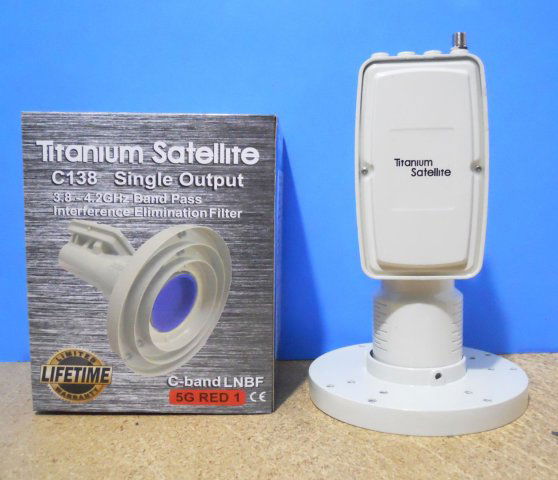You heard it first here on SatelliteGuys! The Titanium Satellite 5G Blue Filter C-Band LNBFs will be released on Monday, December 16th, 2024. First available on the Titanium Satellite and Ebay.com, then within a few weeks, on Amazon.com. The recommended retail prices are $90 for the C140 (Single - 1 Output) and $105 for the C240 (Dual -2 Outputs). Sorry, no preorders will be accepted before the release date.



The BLUE Filter C140 and the C240 LNBF models pass-through the 4000 - 4200 MHz C-Band downlink transponder frequencies and the BPF (Band Pass Filter) attenuates interference from signals outside of this band pass frequency range, including 5G N78 and N77 low and high bands. This new generation of innovative Titanium Satellite interference filtering LNBFs have been in development along with our manufacturing partner over the past two years. Many product revisions were built and real-world tested with the help of satellite hobbyist friends worldwide, as we fine-tuned the design and produced these latest models of our high quality filtered LNBFs. The expanded front-end hairpin filter and tuned cavity isolation blocks provide significantly greater interference rejection than with legacy models. This design required a new body casting to facilitate the larger electronics cavity and shielding blocks. As with all Titanium Satellite products, we don't build or distribute products that we wouldn't use in our own satellite systems. In my opinion, these are the best filtered LNBFs that we have ever offered!


In both LNBF models, LNBF power and polarity selection are voltage controlled with typical 13/18Vdc via the coax with a max current draw of 200mA. The two ports on the C240 model are isolated with independent voltage polarity selection.
Extensive bench testing has shown both the C140 and C240 models to provide excellent interference rejection in all but the most extreme interference situations. The gain and interference rejection of the single and dual output models are the same. There is no interference mitigation advantage in choosing one model over the other. We found that the interfering 5G N78, N77 high and low band signals, which were previously causing transponders between 4000 and 4200MHz to macroblock and lose signal lock, are now attenuated and these target services are within range of error correction and the services are reliably decoded.
Please note: The Titanium Satellite C140 and C240 models are designed to only receive transponder frequencies between 4000 and 4200 MHz (4.0 - 4.2GHz). Most transponders targeting North America have relocated to transponder frequencies within the 4000 - 4200 MHz portion of C-Band. International satellites and transponders not targeting the North American footprint often use frequencies outside of this range.


Thank you to a great SatelliteGuy member N6BY, who has graciously provided real-world 5G testing and feedback throughout the development process. Your assistance is greatly appreciated!
A special thanks goes out to all SatelliteGuys. Thank you for 20 years of friendship and support!
Remember: Enter code "SATGUYS SAVE" at www.titaniumsatellite.com to save 15% on your order.
The BLUE Filter C140 and the C240 LNBF models pass-through the 4000 - 4200 MHz C-Band downlink transponder frequencies and the BPF (Band Pass Filter) attenuates interference from signals outside of this band pass frequency range, including 5G N78 and N77 low and high bands. This new generation of innovative Titanium Satellite interference filtering LNBFs have been in development along with our manufacturing partner over the past two years. Many product revisions were built and real-world tested with the help of satellite hobbyist friends worldwide, as we fine-tuned the design and produced these latest models of our high quality filtered LNBFs. The expanded front-end hairpin filter and tuned cavity isolation blocks provide significantly greater interference rejection than with legacy models. This design required a new body casting to facilitate the larger electronics cavity and shielding blocks. As with all Titanium Satellite products, we don't build or distribute products that we wouldn't use in our own satellite systems. In my opinion, these are the best filtered LNBFs that we have ever offered!
In both LNBF models, LNBF power and polarity selection are voltage controlled with typical 13/18Vdc via the coax with a max current draw of 200mA. The two ports on the C240 model are isolated with independent voltage polarity selection.
Extensive bench testing has shown both the C140 and C240 models to provide excellent interference rejection in all but the most extreme interference situations. The gain and interference rejection of the single and dual output models are the same. There is no interference mitigation advantage in choosing one model over the other. We found that the interfering 5G N78, N77 high and low band signals, which were previously causing transponders between 4000 and 4200MHz to macroblock and lose signal lock, are now attenuated and these target services are within range of error correction and the services are reliably decoded.
Please note: The Titanium Satellite C140 and C240 models are designed to only receive transponder frequencies between 4000 and 4200 MHz (4.0 - 4.2GHz). Most transponders targeting North America have relocated to transponder frequencies within the 4000 - 4200 MHz portion of C-Band. International satellites and transponders not targeting the North American footprint often use frequencies outside of this range.
Thank you to a great SatelliteGuy member N6BY, who has graciously provided real-world 5G testing and feedback throughout the development process. Your assistance is greatly appreciated!
A special thanks goes out to all SatelliteGuys. Thank you for 20 years of friendship and support!
Remember: Enter code "SATGUYS SAVE" at www.titaniumsatellite.com to save 15% on your order.
Attachments
Last edited:




